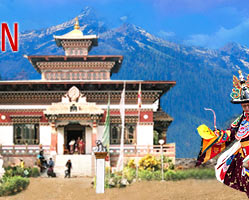Cypress or Cupressus torulosa is the National Tree of Bhutan. Locally, it is known as ‘Tsenden’. It is also referred to as Bhutan Cypress or Himalayan Cypress. Bhutanese consider the cypress tree sacred and held it in great reverence. Its ability to survive in difficult, rugged and harsh terrains and the strong and straight form is believed to be akin to the element of simplicity, hardiness and bravery in the people of Bhutan. Cypress is often planted outside monasteries, dzongs and religious places and its wood and branches has been used as incense for thousands of years. It is often found at 1800-300 m in the Himalayas and need a lot of sunrays. They thrive well in tropical and subtropical rainforests, preferably with calcareous substrates.
Cypress is an evergreen tree that can grow up to 45 m of height and its trunk can have a diameter of 90 cm. The crown of the tree or the treetop can be broadly conical or a large oval in shape. The bark of the cypress tree is thick and either grey brown or brown in color and often peels off in longitudinal strips. The branches of a cypress tree are thin and slender with whip-like tips. Cones of a cypress tree appear in February-March while the seed matures in May-June. Its wood is hard and durable and often pale yellow in color while heartwood is often pale brown in color. The timber of Cypress has straight grain and fine texture and is resistant to termites and insects. Its wood is aromatic too. The essential oil extracted from root-wood of Cypress is used in medicine to cure inflammatory wounds, an antiseptic and to make cosmetics.




